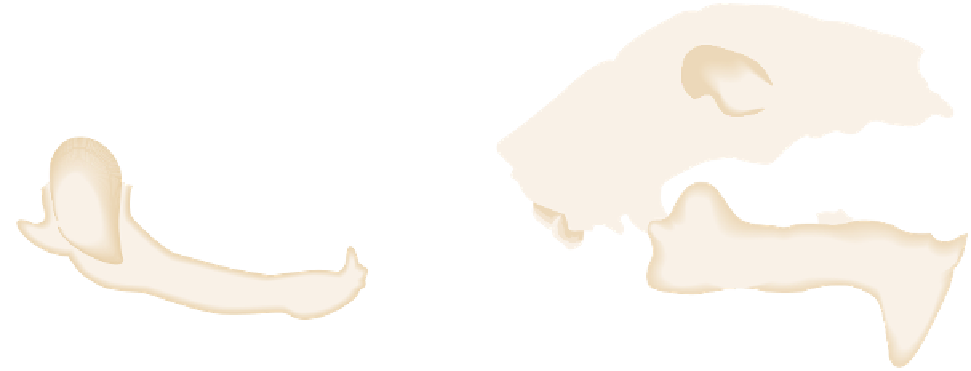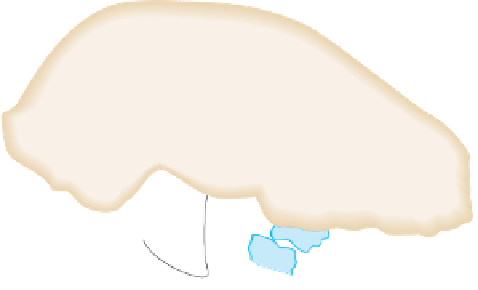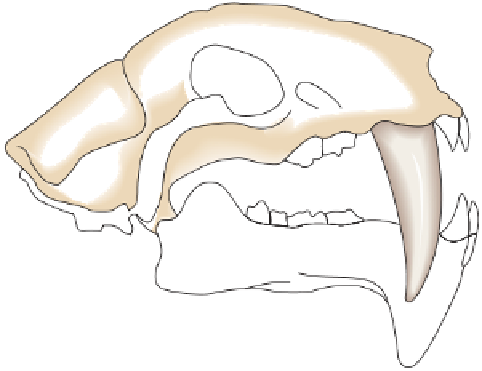Geology Reference
In-Depth Information
◗
Figure 23.26
Teeth of Carnivorous Mammals
Specialized
shearing teeth
Canine
teeth
a
This present-day cat skull and jaw show the specialized
sharp-crested shearing teeth present in carnivorous mammals.
Note also the enlarged canines.
b
A number of Cenozoic saber-toothed cats had huge canine teeth.
This one is the Oligocene saber-toothed
Euismilus
.
During the Eocene, prosimians were abundant, diver-
sifi ed, and widespread in North America, Europe, and Asia.
As the continents moved northward during the Cenozoic
and the climate changed from warm tropical to cooler mid-
latitude conditions, the prosimian population decreased
in both abundance and diversity. Presently, prosimians are
found only in the tropical regions of Asia, India, Africa, and
Madagascar.
Sometime during the Late Eocene, the
anthropoids,
or
higher primates that include monkeys, apes, and humans,
evolved from a prosimian lineage. By the Oligocene, the
anthropoids were a well-established group with both Old
World monkeys (Africa, Asia) and New World monkeys
(Central and South America) having evolved during this
epoch.
Old World monkeys include the macaque, baboon, and
proboscis monkey and are characterized by close-set, downward-
directed nostrils, grasping hands, and a nonprehensile tail
(Figure 23.29b). Present-day Old World monkeys are distributed
throughout the tropical regions of Africa and Asia and are
thought to have evolved from a primitive anthropoid ancestor
sometime during the Oligocene.
New World monkeys are found only in Central and South
America. They are characterized by a prehensile tail, fl attish
face, and widely separated nostrils and include the howler,
spider, and squirrel monkeys (Figure 23.29c). They probably
evolved from African monkeys that migrated across the wid-
ening Atlantic sometime during the Early Oligocene, and they
have continued evolving in isolation to this day.
The
hominoids,
the group containing apes (Figure 23.29d)
and humans (superfamily Hominoidea), diverged from Old
World monkeys sometime before the Miocene, but exactly
when is still being debated. It is generally accepted, how-
ever, that hominoids evolved in Africa from an ancestral
anthropoid group. Although there is still no agreement on
the evolutionary relationships among the early hominoids,
fossil evidence and molecular DNA similarities between
modern hominoid families is providing a clearer picture
of the evolutionary pathways and relationships among the
hominoids.
The
hominids
(family Hominidae), the primate family that
includes present-day humans and their extinct ancestors
(Table 23.2), have a fossil record extending back to almost
7 million years. Several features distinguish them from
other hominoids. Hominids are bipedal; that is, they have
an upright posture, which is indicated by several modifi ca-
tions in their skeleton (
Figure 23.30a). In addition, they
show a trend toward a large and internally reorganized brain
(Figure 23.30b). Other features include a reduced face and
reduced canine teeth, omnivorous feeding, increased manual
dexterity, and the use of sophisticated tools.
Many anthropologists think that these hominid features
evolved in response to major climatic changes that began
during the Miocene and continued into the Pliocene. Dur-
ing this time, vast savannas replaced the African tropical
rain forests where the lower primates and Old World mon-
keys had been so abundant. As the savannas and grasslands
continued to expand, the hominids made the transition from
true forest dwelling to life in an environment of mixed for-
ests and grasslands.
At present, there is no clear consensus on the evolution-
ary history of the hominid lineage. This is due, in part, to
the incomplete fossil record of hominids, as well as new dis-
coveries, and also because some species are known only from
partial specimens or fragments of bone.
◗




















Search WWH ::

Custom Search